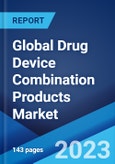The global drug device combination products market size reached US$ 143.6 Billion in 2022. Looking forward, the market is expected to reach US$ 230.4 Billion by 2028, exhibiting a growth rate (CAGR) of 8.20% during 2022-2028.
Drug device combination products comprise medical devices and pharmaceutical ingredients, which assist in delivering the drug to a specific location in the patient’s body. They include vaccine vials packaged with a delivery device, surgical trays with drapes and anesthetic swabs, and prefilled drug delivery systems like syringes, insulin injector pens, and metered dose inhalers. Some of the commonly available drug device combination products are monoclonal antibody combined with a therapeutic drug, pacing lead with steroid-coated tip, and catheter with an antimicrobial coating, and first-aid kits containing bandages and gauze are some.
Drug device combination products comprise medical devices and pharmaceutical ingredients, which assist in delivering the drug to a specific location in the patient’s body. They include vaccine vials packaged with a delivery device, surgical trays with drapes and anesthetic swabs, and prefilled drug delivery systems like syringes, insulin injector pens, and metered dose inhalers. Some of the commonly available drug device combination products are monoclonal antibody combined with a therapeutic drug, pacing lead with steroid-coated tip, and catheter with an antimicrobial coating, and first-aid kits containing bandages and gauze are some.
Drug Device Combination Products Market Trends
The growing prevalence of chronic diseases and the escalating demand for new approaches in treating diseases are among the key factors driving the adoption of drug device combination products across the globe. These products help patients suffering from cancer, heart disease, multiple sclerosis, cerebral palsy, spinal cord injuries, anemia, hepatitis, rheumatoid arthritis, diabetes, and other serious conditions. Moreover, these products offer advantages, such as minimal side effects, controlled drug administration, improved patient compliance, and targeted drug delivery. This, coupled with increasing preferences for smart and precision drug delivery systems that reduce the amount of drug required for therapeutic efficacy, is contributing to the market growth. Apart from this, market players are incorporating technologies into drug device combination products for tracking and monitoring purposes. They are also introducing sophisticated products made using complex active ingredients, formulations, routes of delivery, and dosage forms, such as peptides, liposomes, and transdermal. Additionally, they are focusing on developing next-generation products with high viscosity, formulations, and new classes of biologics. As a result, the demand for these products is anticipated to rise for providing patients treatments and solutions that can better adhere to their therapy.Key Market Segmentation
This research provides an analysis of the key trends in each sub-segment of the global drug device combination products market report, along with forecasts at the global, regional and country level from 2023-2028. The report has categorized the market based on product, application and end user.Breakup by Product:
- Drug Eluting Stents
- Transdermal Patches
- Infusion Pumps
- Drug Eluting Balloon
- Inhalers
Breakup by Application:
- Cardiovascular
- Diabetes
- Cancer Treatment
- Respiratory Diseases
Breakup by End User:
- Hospitals
- Ambulatory Surgical Centers
Breakup by Region:
- North America
- United States
- Canada
- Asia-Pacific
- China
- Japan
- India
- South Korea
- Australia
- Indonesia
- Europe
- Germany
- France
- United Kingdom
- Italy
- Spain
- Russia
- Latin America
- Brazil
- Mexico
- Middle East and Africa
Competitive Landscape
The competitive landscape of the industry has also been examined along with the profiles of the key players being Abbott Laboratories, Baxter International Inc., Bayer AG, Becton Dickinson and Company, Boston Scientific Corporation, GlaxoSmithKline plc, Johnson & Johnson, Medtronic plc, Novartis AG, Smith & Nephew plc, Stryker Corporation and Terumo Corporation.Key Questions Answered in This Report:
- How has the global drug device combination products market performed so far and how will it perform in the coming years?
- What has been the impact of COVID-19 on the global drug device combination products market?
- What are the key regional markets?
- What is the breakup of the market based on the product?
- What is the breakup of the market based on the application?
- What is the breakup of the market based on the end user?
- What are the various stages in the value chain of the industry?
- What are the key driving factors and challenges in the industry?
- What is the structure of the global drug device combination products market and who are the key players?
- What is the degree of competition in the industry?
Table of Contents
1 Preface3 Executive Summary11 Value Chain Analysis13 Price Analysis
2 Scope and Methodology
4 Introduction
5 Global Drug Device Combination Products Market
6 Market Breakup by Product
7 Market Breakup by Application
8 Market Breakup by End User
9 Market Breakup by Region
10 SWOT Analysis
12 Porters Five Forces Analysis
14 Competitive Landscape
Companies Mentioned
- Abbott Laboratories
- Baxter International Inc.
- Bayer AG
- Becton Dickinson and Company
- Boston Scientific Corporation
- GlaxoSmithKline plc
- Johnson & Johnson
- Medtronic plc
- Novartis AG
- Smith & Nephew plc
- Stryker Corporation
- Terumo Corporation
Methodology

LOADING...
Table Information
| Report Attribute | Details |
|---|---|
| No. of Pages | 143 |
| Published | November 2023 |
| Forecast Period | 2022 - 2028 |
| Estimated Market Value ( USD | $ 143.6 Billion |
| Forecasted Market Value ( USD | $ 230.4 Billion |
| Compound Annual Growth Rate | 8.2% |
| Regions Covered | Global |
| No. of Companies Mentioned | 12 |









